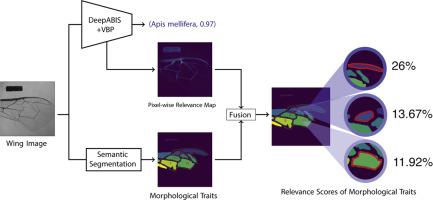Ecological Informatics ( IF 5.8 ) Pub Date : 2020-08-31 , DOI: 10.1016/j.ecoinf.2020.101138 Keanu Buschbacher , Volker Steinhage

|
Deep Neural Networks have proven to be exceptionally successful in applications such as image or speech recognition, yielding prediction results with high accuracy and precision. But due to their black-box nature, Deep Neural Networks are criticized to yield non-transparent and non-explainable results. In the field of taxonomic identification, explainability of the identification results derived by automated image-based identification approaches should rely on common observable morphological traits and their relevance to the derived results. Extending previous work on the deep learning-based Automated Bee Identification System DeepABIS, an approach is presented that equips DeepABIS with a relevance ranking of morphological traits according to their contributions to the prediction results of the automated image-based species identification. The approach shows three steps: (1) Using Visual Backpropagation, a relevance map is generated that maps each pixel of an input image to a relevance score indicating its relevance to the identification result. (2) A deep neural network for semantic segmentation is employed to extract regions of the input image that depict morphological traits (in this work veins, cells and junctions of bee wings). (3) In the fusing step, the morphological traits are assigned aggregated relevance scores using the pixel-wise relevance map obtained in the first step. Experimental results confirm the obtained relevance rankings of the morphological traits by an evaluation using the model-agnostic importance metric Single Feature Importance (SFI).
中文翻译:

视觉形态特征的提取及其相关性排序
事实证明,深度神经网络在图像或语音识别等应用中非常成功,可产生高精度和高精度的预测结果。但是由于其黑盒性质,人们批评深度神经网络产生非透明且无法解释的结果。在分类学鉴定领域,通过基于图像的自动识别方法得出的鉴定结果的可解释性应依赖于常见的可观察形态特征及其与所得结果的相关性。扩展了基于深度学习的自动蜜蜂识别系统的先前工作DeepABIS,提出了一种方法,根据DeepABIS对基于图像的自动物种识别的预测结果的贡献,为其提供形态性状的相关性排名。该方法显示了三个步骤:(1)使用可视反向传播,生成了一个关联图,该关联图将输入图像的每个像素映射到一个关联分数,以指示其与识别结果的关联。(2)使用深度神经网络进行语义分割,以提取输入图像中描述形态特征的区域(在此工作中,是指蜂翼的静脉,细胞和交界处)。(3)在融合步骤中,使用第一步中获得的像素相关度图,为形态特征分配聚合的相关性得分。单一功能重要性(SFI)。











































 京公网安备 11010802027423号
京公网安备 11010802027423号